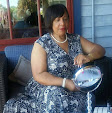
Most Interesting Ancestor- Fannie Rowland Thompson Gilliam
I loved to hear my mother, Vivian Rowland Jones, talk about her favorite aunt. Fannie Rowland Thompson Gilliam was born in 1867 to Hester Duckworth, a former slave and the man who brought her from South Carolina as part of his property, Dr. James Rowland (aka Doc Rowland) in LaPile, Arkansas of Union County. Fannie was one of three children of that union. The other two were a girl who died in infancy (name unknown) and my great-great grandfather, John Rowland. That made her my great-great aunt, the sister of my mother’s grandfather.
Fannie appeared to have the most colorful life in the Rowland clan as she is the one who got away from the “sticks” of LaPile in rural southern Arkansas and the harsh farming life of that community during a time when the majority of African Americans in the southern United States were striving to survive less than twenty years coming out of slavery. Doc Rowland, who was her father and the man who was the slaveholder of her mother, acknowledged his children and they took the Rowland surname. Like many white men who fathered children with black women, he had an interest in their life. It is unknown if he had part in Fannie pursuing an education. I do not know how it was Fannie attended college in New Orleans around the 1880s, nor could my mother or aunt tell me, which would be a six hour drive from her hometown by today’s standards. Nevertheless, she attended Straight University, a college for Negroes, which offered courses of study ranging from elementary to college-level courses in music, law and theology. In 1886, Straight discontinued the Law Department and began to focus on the liberal arts, industrial arts, and teacher training. In 1934 Straight College (changed in 1915) merged with New Orleans University to become Dillard University, a historically Black college which still exists.
My mother remembers a picture of Fannie and some of her classmates, all light-skinned women as she was. It is not known if she completed college or what was her course of study. There is a story that one day she and a group of her classmates were walking down the street near the university and her bloomers fell down on the ground. She was of course embarrassed. One of the girls said “Just step over them and keep on walking.” And that is what she did.
Fannie married a J. Thompson in her 20s and they were later divorced. No children came from that union. Reportedly, she was unable to have children. She had another short-lived marriage thereafter. In 1908, at 41 years old she married widower Robert Gilliam from Clark County. Robert was a widower and father of a young daughter, Otelia. Otelia Gilliam later married Samuel Rowland, who was Fannie’s nephew through her brother John, and my mother’s father. That is how my mother’s maternal and paternal side became joined. When I was younger I would get confused when my mother referred to Fannie as both her great aunt and her step-grandmother. They all lived in LaPile, then Huttig in Union County. Fannie became more like a mother than a step-mother to Otelia and they shared a close relationship.
Fannie was a lover of literature as evidenced by her collection of books by Shakespeare and other literary wonders such as the Afro- American Encyclopedia 1891 that my mother still has. According to my mother, she also liked to sew and was quite fashionable. A few years ago when were visiting Huttig, we went through an old trunk at “Old Place” that was filled with antique buttons that Aunt Fannie and Grandmother and Otelia used in their sewing. She was of medium height, a light-skinned woman with long curly, fine hair. She belonged to the Mt. Olive A.M.E. Church in Huttig, a community next to LaPile. Fannie died in 1945 and was buried at Batts Chapel Cemetery.
